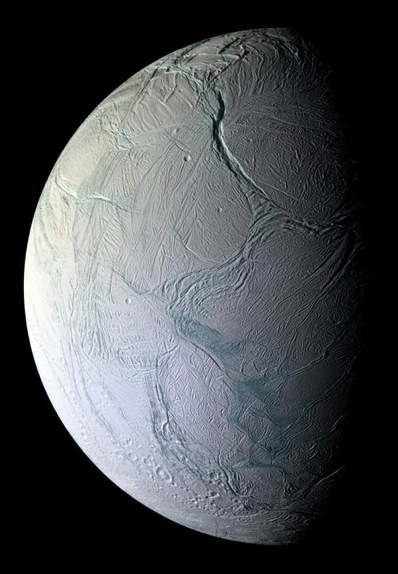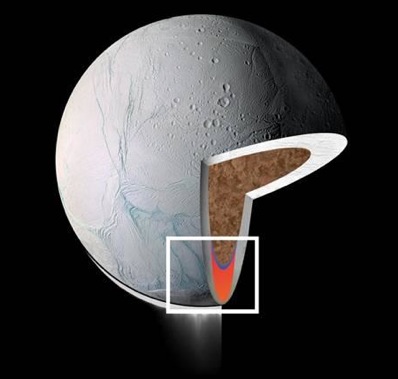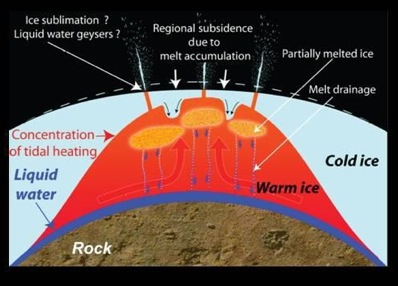



|

|

Episodic "burping" explains Enceladus' behaviour
DR EMILY BALDWIN
ASTRONOMY NOW
Posted: 12 January 2010


Enceladus' young southern hemisphere is likely caused by blobs of warm ice that periodically rise to the surface, according to a new model published in Nature Geoscience.
“Cassini appears to have caught Enceladus in the middle of a burp,” says planetary scienctist Francis Nimmo of the University of California Santa Cruz. “These tumultuous periods are rare and Cassini happens to have been watching the moon during one of these special epochs.”
 Cassini captured this 28-image mosaic of Enceladus during its 5 October 2008 flyby and shows a surface replete with fractures, folds and ridges, and a scarcity of craters, indicating its young age. Image: NASA/JPL/Space Science Institute. Cassini captured this 28-image mosaic of Enceladus during its 5 October 2008 flyby and shows a surface replete with fractures, folds and ridges, and a scarcity of craters, indicating its young age. Image: NASA/JPL/Space Science Institute.
The south polar region of Enceladus is dominated with fissures, the so-called tiger stripes, from which water vapour and other particles emanate. While the new theory doesn't directly link the idea of resurfacing to the formation of fissures and jets, it does help to solve the mystery of why the crust is so young.
The story begins about four years ago, when Cassini's instruments measured a heat flow of some six gigawatts – at least three times as much heat as an average region of Earth of similar area would produce, a surprising finding given Enceladus' small size of just 500 kilometres in diameter. Later, Cassini found that the region was also expelling argon, which comes from rocks decaying radioactively at a well-defined rate of decay. But neither radioactive decay nor tidal movement, or the two processes combined, could explain the high release of energy. Furthermore, the surface ages of different regions varied from ancient, 4.2 billion year old cratered plains in the northern hemisphere, through to equatorial regions displaying a range of ages between 170 million and 3.7 billion years, right down to an incredibly young – geologically speaking –100 million to 500,000 years at the south pole.
“This episodic model helps to solve one of the most perplexing mysteries of Enceladus,” says Bob Pappalardo, Cassini project scientist at NASA’s Jet Propulsion Laboratory. “Why is the south polar surface so young? How could this amount of heat be pumped out at the moon’s south pole? This idea assembles the pieces of the puzzle.”
  Explanations for the source of intense heat measured at Enceladus' south polar region. Scientists infer that the temperature of the ice must be close to its melting point (shown in red). A layer of liquid water (dark blue) might exist between the ice and the silicate core (brown), allowing the ice to deform independent of the rock, providing even more mechanical energy and more flexing of the icy shell for extreme tidal heating. Image: NASA/JPL. Explanations for the source of intense heat measured at Enceladus' south polar region. Scientists infer that the temperature of the ice must be close to its melting point (shown in red). A layer of liquid water (dark blue) might exist between the ice and the silicate core (brown), allowing the ice to deform independent of the rock, providing even more mechanical energy and more flexing of the icy shell for extreme tidal heating. Image: NASA/JPL.
Nimmo, and Craig O’Neill of Macquarie University in Sydney, Australia, adapted a model O'Neill had previously designed for the Earth's crust for Enceladus' cold ice crust. Picking a crust strength between that of the malleable tectonic plates of Earth and the rigid crust of Venus, the revised model showed that heat building up from the interior of Enceladus could be released in episodic bubbles of warm, light ice rising to the surface – rather much like the rising blobs of heated wax in a lava lamp – which in turn would send cold, heavier ice down into the interior. At Enceladus, warm is just below freezing (273 kelvin) while cold is around 80 degrees kelvin.
The model works when the periods of churning and resurfacing – "burping" – last some 10 million years, while periods of quiescence, when the surface ice is undisturbed, lasts for between 100 million and two billion years. The model suggests the active periods have occurred for up to 10 percent of the time that Enceladus has existed and have recycled 10 to 40 percent of the surface, with the active south polar region accounting for 10 percent of Enceladus' surface.
|

|

|

|
|



